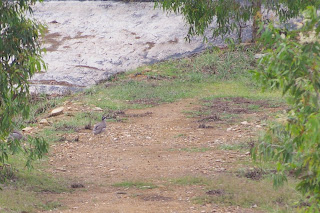The weather is really starting to warm up now and birding trips to Julatten and the Tablelands are a welcome relief from the humidity of the coast. Over the last few weeks we have visited sites as far afield as Georgetown.
Several trips have included the Mareeba area and Lake Mitchell which has been very productive of late. We sighted a Grey Wagtail, a rare visitor to Northern Australia. They breed in Europe and Asia and then migrate to Africa, Papua New Guinea, Indonesia and Malaysia from November to April. In Non-breeding plumage the Grey Wagtail looks very similar to the Yellow Wagtail. The Grey Wagtail has pinkish colour legs and a longer tail then the Yellow. The small lagoons and dams around Mareeba are good for water birds at this time of year. We are seeing Pacific Black Duck, Hardhead, Australian Wood Duck, Green and Cotton Pygmy Goose, Grey Teal, Magpie Goose, Cormorant, Darter, Black Swan, Jacana and many others.
At Lake Mitchell we flushed a small Button-quail. It was too fast for us to positively identify but could have been a Red-chested Button-quail which have been seen here recently or even a Buff-Breasted Button-quail which is quite rare. Unfortunately all efforts to locate the bird again failed. Snipe are also plentiful at this time of year with a lot of sightings of Latham’s Snipe. Some are of the opinion that these are Swinhoe’s Snipe but in my opinion, you can’t tell the difference unless you have the bird in your hands. I suppose the debate will continue until some serious research is done.
 |
| Taipan |
Julatten. After weeks of hearing the calls and no sightings, the Buff-breasted Paradise Kingfisher has finally put in an appearance. The Metallic Starlings are now well into their nest building and Channel-billed Cuckoo are plentiful. Snakes are also on the move with a two-and-a-half metre long Taipan spotted at Abattoir Swamp. White-throated Needletail have also put in an appearance. Last week at Kuranda, we had some great views of these birds doing some low level flying.
We had good sightings of Black-necked Stork and Buff-banded Rails in the Cooya Beach area, as well as Mangrove Robin and Varied Honeyeater. Waders are also plentiful on the mud flats at low tide. A short visit to the area two weeks ago produced 41 species along the mangroves, mud flats and cane fields.
 |
| Golden Bowerbird's Bower |
Our Georgetown trip started with a visit to Hastie’s Swamp near Atherton. We had 44 species within half-an-hour! The list included White-browed Scrubwren, seen along the road side, and two White-bellied Sea-eagles. The Eagles seemed to be taking delight in putting the Whistling-Ducks to flight in their thousands. We had a brief stop at Longlands Gap State Forest to see the Golden Bowerbird at its bower. We also spotted a Tooth-billed Bowerbird calling from above his “bower”, a cleared area decorated with fresh upturned leaves. Also seen were Mountain Thornbill, Atherton Scrubwren and Bridled Honeyeater.
 |
| Golden Bowerbird |
Next stop was Warruma Swamp at Mt Garnet. Of note here were Great and Pied Cormorant, Brolga and Blue-winged Kookaburra. Mt Surprise was good for Red-winged Parrot, Channel-billed Cuckoo and Squatter Pigeon.
 |
| Warruma Swamp |
At Georgetown our first stop was at the rubbish tip which is always good for Australian Bustard. We also saw Nankeen Night Heron, Diamond Dove, and Galah. A walk around the racecourse produced Horsfield’s Bushlark, Rufous Songlark, White-throated Gerygone and White-winged Triller.
We arrived at the Cumberland Dam, about 20km beyond Georgetown, at about 3.30pm. While taking a break under the trees with a cup of tea, we were visited by Rufous-throated Honeyeater, Yellow-tinted Honeyeater, Paperbark Flycatcher and several Pale-headed Rosella. The best views of the dam are from the top of the earth wall, sitting in a camp chair under a tree. You can find our list of birds here. A walk along the back of the wall produced a small flock of Zebra Finch and some Double-barred Finch. Our plan was to be back at the dam at first light. Heavy rain, however, put paid to that and we headed back to the coast re-visiting some of our stops of the previous day.











